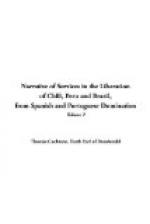On the 15th we again sailed from Huacho, to renew the blockade at Callao, beyond which nothing could be done; though even this was of importance, as cutting off supplies from the capital, the inhabitants of which, in consequence of the privations they were subjected to, caused great uneasiness to the Viceregal Government.
Several attempts were now made to entice the remaining Spanish naval force from their shelter under the batteries, by placing the Esmeralda apparently within reach, and the flag-ship herself in situations of some danger. One day I carried her through an intricate strait called the Boqueron, in which nothing beyond a fifty-ton schooner was ever seen. The Spaniards, expecting every moment to see the ship strike, manned their gun-boats, ready to attack as soon as she was aground, of which there was little danger, for we had found, and buoyed off with small bits of wood invisible to the enemy, a channel through which a vessel could pass without much difficulty.
On the 2nd of December the Esmeralda, being in a more than usually tempting position, the Spanish gun-boats ventured out in the hope of recapturing her, and for an hour maintained a smart fire; but on seeing the O’Higgins manoeuvring to cut them off, they precipitately retreated.
The preceeding successes caused great depression amongst the Spanish troops, and on the following day the battalion of Numantia, numbering 650 disciplined men, deserted in a body, and joined the Chilian forces at Chancay. On the 8th, forty Spanish officers followed their example; and every day afterwards, officers, privates, and civilians of respectability, joined the patriot army, which thus became considerably reinforced; the defection of so large a portion of his troops being a severe loss to the Viceroy.
On the 6th, Colonel Arenales, who, after his previous success, had marched into the interior, defeated a division of the royalist army at Pasco. On his proceeding to Huamanga, the authorities fled, and the inhabitants declared themselves independent. Tarma was next abandoned, and followed the same example, as did Huanuco, Cuenca, and Loxa; whilst, on the news of the capture of the Esmeralda arriving at Truxillo, that important province also revolted, under the direction of the Spanish governor, the Marquis of Torre Tagle.
Notwithstanding this succession of favourable events, General San Martin still declined to march on Lima, remaining inactive at Haura, though the unhealthy situation of the place was such, that nearly one-third of his troops died of intermittent fever, during the many months they remained there. In place of securing the capital, where the army would have now been welcomed, he proposed to send half the army to Guayaquil, in order to annex that province, this being the first manifestation on the part of General San Martin to found a dominion of his own—for to nothing less did he afterwards aspire, though the declared object of the expedition was to enable the South Pacific provinces to emancipate themselves from Spain, leaving them free to choose their own governments, as had been repeatedly and solemnly declared, both by the Chilian Government and himself.




